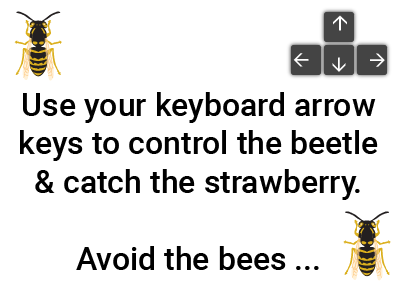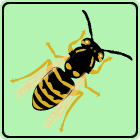


You got
| time | - | (health ÷ 10) | = | score | |
| 100 | - | (50 ÷ 10) | = | 127 |
3 scores max per player; No foul language, show respect for other players, etc.
Name | Score | Date | ||
|---|---|---|---|---|
| 1 | ||||
| 2 | ||||
| 3 | ||||
| 4 | ||||
| 5 | ||||
| 6 | ||||
| 7 | ||||
| 8 | ||||
| 9 | ||||
| 10 |

Game: THE BEETLE AND THE BEE
Aim: Collect the strawberries, avoid the bees
Method:
Move the beetle with the arrow keys or by tapping the screen. When the beetle catches the strawberry, you must answer the question. If you get it right you keep the strawberry and earn points.
Your final score is based on the time taken minus health lost divided by 10.

anonymous 🦄🦄🦄
"Angles on a straight line: missing angle"
The beetle and the bee game to practice
'Identify improper fractions' for 6th grade
6th grade / Number / Fractions / Fraction basics / Identify improper fractions
Identify improper fractions
What is an improper fraction?
An improper fraction is a fraction where the numerator (the number on the top) is greater than or equal to the denominator. Another name for improper fraction is top-heavy fraction.
Mixed fractions and improper fractions
An improper fraction like 3/2 can be converted to a mixed fraction by dividing the numerator by the denominator and expressing the remainder as a fraction. Converting the improper fraction 5/2 to a mixed fraction gives 2½.
A mixed fraction like 1½ can be converted to an improper fraction. To convert a mixed fraction to an improper fraction, multiply the denominator of the fraction part by the whole number, then add the numerator. Put the total over the denominator to create the improper fraction. Converting the mixed fraction 1½ to an improper fraction gives:
(2 x 1) + 1 / 2 = 3/2 (three over two).
With our The beetle and the bee math game you will be practicing the topic "Identify improper fractions" from 6th grade / Number / Fractions / Fractions. The math in this game consists of 16 questions that ask you to identify the fraction or fractions that are improper fractions.
6th grade : Fractions
Sections
5 sub categories:
- Fraction basics
- Add fractions
- Subtract fractions
- Multiply fractions
- Divide fractions
In Year 7 in the UK, students typically continue to build upon their understanding of fractions, which they started developing in earlier grades. Here's an overview of key concepts related to fractions that are commonly taught in Year 7:
Understanding Fractions: Students learn that fractions represent parts of a whole or a group. They understand that a fraction consists of a numerator (the number above the fraction line) and a denominator (the number below the fraction line). The numerator represents the number of parts being considered, while the denominator represents the total number of equal parts that make up a whole.
Equivalent Fractions: Students explore equivalent fractions, which are different fractions that represent the same value. They learn that equivalent fractions can be obtained by multiplying or dividing both the numerator and the denominator by the same number. For example, 1/2 is equivalent to 2/4, 3/6, and so on.
Comparing and Ordering Fractions: Students learn to compare fractions and order them from least to greatest or greatest to least. They understand that when fractions have the same denominator, the one with the larger numerator is greater. When fractions have different denominators, they convert them to equivalent fractions with a common denominator to compare.
Adding and Subtracting Fractions: Students begin to add and subtract fractions with the same denominator (for example, 1/4 + 2/4). They also learn to add or subtract fractions with different denominators by finding a common denominator and then adjusting the numerators accordingly.
Multiplying and Dividing Fractions: Students explore multiplication and division of fractions. They learn to multiply fractions by multiplying the numerators together and the denominators together. For division, they learn to invert the second fraction and multiply. For example, to divide 1/4 by 1/2, you multiply by the reciprocal, which is 2/1.
Fractions in Real-Life Contexts: Students apply their understanding of fractions to real-life situations, such as measurements, recipes, and problem-solving scenarios. They learn to interpret and solve word problems involving fractions.

Fast moving interactive game to learn math where you control the beetle and the bee moves randomly about the screen. The bee should be avoided and the strawberries collected by answering math questions from the topic you have selected - this is learning math for fun!
Notes
- Fast moving game with character control via keyboard arrows.
- Suitable for tablets and mobiles by tapping the direction you want the beetle to go.
- Learn or revise your math and win strawberries for your beetle!
- On the second set of 5 levels there are 2 bees to avoid...
- It's a fun game, but it can be hard to get through to the end!
UXO * Duck shoot * The frog flies * Pong * Cat and mouse * The beetle and the bee
Rock fall * Four in a row * Sow grow * Choose or lose * Mix and match

Latest leaderboard entries: Beetle & bee




How to play The beetle and the bee to practice
'Identify improper fractions' for 6th grade

The beetle is hungry and sees the tasty strawberry but the angry bee wants to sting it...
- Choose "The beetle and the bee" from the games selection page.
- When you start the game you are in the first level of a simple maze.
- You are the beetle and you want to eat the strawberry but there is a bee who will try to sting you.
- Each time the bee stings you, you lose a little of your life.
- Use your keyboard's arrows or tap the screen to move the beetle.
- Move the beetle around the obstacles avoiding the bee and get to the strawberry.
- When you catch a strawberry, you will get a math question from your selected topic.
- Select or enter the correct answer.
- If you are right you win the strawberry - now you must get back to the swirly "portal" at the top right of the screen.
- Entering the portal takes you to the next level of the maze.
- The game gets harder after the first 5 levels - now there are 2 bees trying to sting you...
- You need to complete all the levels without dying of bee stings to win.
- Your final score is your time taken minus your remaining health divided by 10.









